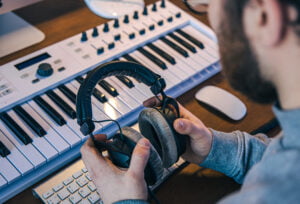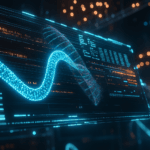Technology is a key factor in defining and extending the limits of human expression in the modern environment of art and creativity. One technology in particular, the Field-Programmable Gate Array (FPGA), has become well-known for its adaptability and usefulness in artistic pursuits.
Originally intended for computing, these electronic devices are now transforming the art world. FPGAs are opening up a whole new world of creative possibilities in fields including fashion, music, visual arts, and immersive installations.
This study employs FPGAs to explore the symbiotic relationship between technology and art. We will describe FPGAs, look at how they function in various artistic contexts, and talk about the difficulties and moral issues that come with them.
We’ll explore this area and see how FPGAs are altering the creative process and expanding the frontiers of artistic innovation, providing a window into a future where imagination and technology come together to produce amazing works of art.
FPGAs in Visual Art
The field of visual art has discovered a novel and inventive use for Field-Programmable Gate Arrays (FPGAs). FPGAs have been adopted by creative technologists and artists to investigate new avenues of expression and interactivity in their visual creations. We will explore the several applications of FPGAs in visual art in this section, which opens up a plethora of possibilities for fusing creativity and technology.
A. Real-time Graphics and Animation
The production of real-time visuals and animations is among the most amazing applications of FPGAs in visual art. Because FPGAs run complex algorithms quickly, artists are able to create complex visual effects and animations in real-time. This feature makes it possible to create interactive artwork that reacts dynamically to the surroundings or input from viewers in performances and installations.
FPGAs have played a key role in the creation of digital artworks that change and adapt in response to different inputs, like sensor data or interactions from the audience. These dynamic visual encounters give the work a dimension of interaction and unpredictability that increases its power and appeal.
B. FPGA-based Image Processing and Manipulation
Due to their high parallel processing capacity, FPGAs are ideal for handling and processing images. Artists utilize FPGAs to alter and apply complex filters, effects, and transformations to both static and moving images. This technology allows artists to create digital artwork that surpasses what is artistically possible.
Both practical applications and creative expression are greatly impacted by real-time photo modification using FPGAs. Whether they are used for immersive visual experiences, generative art production, or photo editing, FPGAs provide artists with a powerful arsenal to realize their goals.
C. Interactive and Generative Art
The generative and interactive art styles that have gained popularity in recent years could not exist without FPGAs. Generative art, which is based on algorithms and randomness, can be enhanced by FPGAs to produce constantly changing, visually interesting experiences. In interactive art displays, like those found in galleries and museums, FPGAs are commonly utilized to detect and respond to human touch.
FPGAs’ ability to interpret sensory data from a range of sources, including cameras, microphones, and touch sensors, allows artists to produce immersive and responsive artwork. This project bridges the gap between the artist and the audience by fusing technology and art to create an engaging and interactive experience.
FPGAs in Music and Sound
The combination of creativity and technology has drastically changed how we listen to and make music and sound. In this area, Field-Programmable Gate Arrays, or FPGAs, have developed into incredibly helpful tools that let musicians, sound designers, and artists explore with novel sonic expression. In this section, we will delve into the fascinating world of FPGAs in sound and music, examining their uses in processing, audio synthesis, and real-time performance.
A. Synthesis and Processing of Audio using FPGAs
FPGAs’ flexibility and parallel processing capabilities make them an ideal platform for signal processing and music synthesis. Here, we’ll look at the different applications of FPGAs in the audio domain:
Real-time Audio Synthesis: Real-time, sophisticated, dynamic sounds can be produced with FPGAs. FPGA-based synthesizers can be programmed by musicians and sound designers to produce a wide range of sounds, from conventional instrument sounds to experimental and otherworldly tones.
Effects Processing: Audio effects processing requires complex algorithms, which FPGAs are well-suited to handle. FPGA-based effects processors are used by audio engineers and musicians to produce distortions, delays, reverbs, and other audio effects.
High-Quality Audio Playback: Due to their reputation for handling high-resolution audio data, FPGAs are a good fit for digital-to-analog converters (DACs) and audiophile-grade audio playback systems.
B. Real-time Music Performance and Composition with FPGAs
FPGAs have found their way into live music performance and composition, transforming the way artists interact with technology during their creative process:
Real-time Music Generation: Musicians can use FPGAs to create generative music systems that react to the environment, audience, or even other musicians in real time. These systems produce evolving musical compositions, enhancing the spontaneity of live performances.
Instrument and Controller Design: FPGAs enable the development of custom electronic instruments and controllers that provide unique interfaces for musicians. These devices can be tailored to individual performance needs and preferences.
Digital Audio Workstations (DAWs): FPGAs can be integrated into digital audio workstations to handle intensive processing tasks in music production. This can lead to reduced latency and improved overall performance.
FPGAs in Wearable Technology and Fashion
The incorporation of cutting-edge technologies like Field-Programmable Gate Arrays (FPGAs) has revolutionized wearable technology and fashion in recent years, creating new avenues for usefulness, interactivity, and creative expression.
This section examines the intriguing relationship between wearable technology and FPGAs in the fashion industry, demonstrating how these programmable gadgets are expanding the realm of what is feasible for apparel and accessories.
I. FPGAs in Smart Clothing and Accessories
More than just fitness trackers and smartwatches, wearable technology has become mainstream. Designers and engineers are now able to incorporate intelligence and processing power right into apparel and accessories thanks to FPGA technology.
A. Smart Fabrics
- Explanation of smart fabrics and how FPGAs enable them.
- Examples of smart fabrics that incorporate FPGAs, such as those with environmental sensors or haptic feedback systems.
B. Health and Wellness Applications
- Discuss how FPGAs are used to monitor vital signs, such as heart rate and body temperature.
- Highlight clothing designed for medical monitoring and wellness management.
C. Connectivity and Data Collection
- Explain how FPGAs facilitate wireless communication, allowing wearable devices to connect to smartphones and other IoT devices.
- Explore applications in data collection, including GPS tracking and environmental sensing.
Interactive and Responsive Fashion Designs with FPGAs
FPGAs enable fashion designers to create garments and accessories that react to their environment, wearer’s movements, or even social interactions.
A. Interactive Garments
- Discuss garments that respond to touch, movement, or gestures.
- Provide examples of interactive clothing that changes color or shape in response to stimuli.
B. Wearable Art
- Explore the use of FPGAs in fashion pieces that incorporate artistic elements, such as LEDs, displays, and sound.
- Showcase projects that bridge the gap between technology and art.
C. Social Interaction
- Describe how FPGAs can be used to create clothing that responds to social cues, such as proximity to others or social media interactions.
- Examine the implications for social engagement and self-expression.
FPGAs in Multimedia Installations
Multimedia installations offer immersive experiences that appeal to numerous senses at once, representing a fascinating fusion of art and technology. Multimedia art installations have benefited greatly from the use of Field-Programmable Gate Arrays (FPGAs), which allow technologists and artists to create dynamic, engaging, and innovative experiences that push the frontiers of creativity.
A. Immersive Multimedia Art Installations with FPGAs
FPGAs are essential for accomplishing the goal of immersing spectators in another world, which is a common goal of multimedia installations. Real-time processing of audio, video, and sensor data is made possible by these adaptable hardware platforms, which facilitates the smooth integration of various media formats. FPGAs can be programmed by artists to synchronise interactive elements, audio, and images in complex and accurate ways.
1. Synchronization of Audio and Visuals
- FPGAs allow for the synchronization of audio and visual elements to create immersive experiences that resonate with the viewer.
- Real-time audio processing can be fine-tuned with FPGA-based solutions, ensuring that sound and visuals align seamlessly.
2. Data Processing for Interactivity
- FPGAs are used to process data from various sensors, cameras, and other input devices in real time, making interactive installations responsive to the audience.
- This interactivity often includes gestures, movements, and even biometric data, enhancing the viewer’s engagement.
B. Interactive and Sensor-Driven Experiences
Interactivity is a hallmark of modern multimedia installations, and FPGAs offer the necessary computational power to create responsive and dynamic experiences.
1. Gesture and Motion Control
- FPGAs enable the implementation of gesture and motion control systems that respond to the movements and actions of viewers.
- This technology enhances the audience’s participation, making them an integral part of the installation.
2. Sensor Integration
- Various sensors, such as proximity sensors, accelerometers, and environmental sensors, can be seamlessly integrated with FPGAs to collect data for real-time adaptation of the installation.
- Environmental data can be used to alter the installation’s behavior, creating a dynamic and context-aware experience.
C. Collaborations Between Artists, Engineers, and Technologists
Multimedia installations often require a collaborative effort between artists, engineers, and technologists. The unique flexibility of FPGAs allows these different disciplines to work together harmoniously.
1. Cross-Disciplinary Collaboration
- Artists collaborate with FPGA engineers and software developers to bring their creative vision to life.
- This collaboration bridges the gap between art and technology, resulting in innovative installations.
2. Innovation in Design and Execution
- FPGAs open up new possibilities in terms of design and execution.
- Engineers and technologists use their expertise to push the boundaries of what’s technically feasible, giving artists more creative freedom.
- The combination of FPGA technology and multimedia installations has ushered in an era of unprecedented creativity. Artists and technologists continue to explore new horizons, redefining how we experience and interact with art. This synergy of creativity and technology exemplifies the transformative power of FPGAs in multimedia art installations.
Challenges and Considerations
Field-programmable gate arrays, or FPGAs, have a lot of potential to improve innovation and creativity in the arts, but integrating them into artistic and creative enterprises is not without its difficulties. For artists, designers, and makers to properly utilize the capability of FPGAs, they must comprehend and address these difficulties. Here, we examine some of the main difficulties and things to think about:
A. Technical Challenges
Complex Programming: FPGAs require specialized knowledge and programming expertise. Configuring them involves creating hardware descriptions using hardware description languages (HDLs) like VHDL or Verilog. This complexity can be a barrier for artists and designers without a technical background.
Resource Constraints: FPGAs have limited resources, including logic gates, memory, and processing power. Artists must optimize their designs to fit within these constraints, which can be particularly challenging for computationally intensive projects.
Compatibility: Compatibility with other hardware and software can be an issue. Artists may need to adapt their projects to work with specific FPGA development boards and tools, which can limit creative flexibility.
B. Ethical and Environmental Considerations
Electronic Waste: As FPGAs evolve and become more accessible, older models and components can become obsolete. This contributes to electronic waste, which poses environmental challenges. Creators should consider the environmental impact of their projects and aim for sustainability.
Ethical Use: The use of FPGAs in creative projects can raise ethical questions, especially when dealing with surveillance, privacy, or the potential for misuse. Artists and designers should carefully consider the ethical implications of their work and adhere to ethical guidelines.
C. Accessibility and Cost Issues
Cost: FPGAs and related development tools can be expensive. This cost can be a significant barrier for independent artists and creators, limiting access to this technology.
Training and Education: Learning to work with FPGAs requires time and resources for training and education. Artists and designers may need to invest in courses or workshops to develop the necessary skills.
Interdisciplinary Collaboration: Collaboration between artists, engineers, and technologists is frequently necessary to close the gap between artistic originality and technical expertise. Cooperation and effective communication might be difficult, yet successful FPGA-based projects depend on them.
The Future of FPGAs in Art and Creativity
Field-programmable gate arrays, or FPGAs, have a bright future in the creative industries as these adaptable hardware platforms keep developing and finding new uses in a wide range of artistic fields. FPGAs will probably play a bigger and more varied role in the future as technology develops, affecting how artists and creators plan and execute their ideas. We will examine the possible paths and new developments that are influencing the use of FPGAs in art and creativity in the future in this part.
Integration with AI and Machine Learning
- FPGAs are increasingly being used to accelerate AI and machine learning workloads. In the creative realm, this could mean more intelligent and adaptive art and media generation.
- Artists might employ FPGAs to create AI-assisted tools that help in content generation, style transfer, or even making sense of vast datasets for inspiration.
Sustainability and Eco-friendly Practices
- As environmental concerns become more critical, the use of power-efficient FPGAs could play a pivotal role in eco-friendly art installations and projects.
- Artists and engineers are likely to collaborate on designs that minimize power consumption while maintaining high performance, reducing the ecological footprint of technology-driven art.
Interdisciplinary Collaborations
- The future of FPGAs in art and creativity will likely see more interdisciplinary collaborations between technologists, artists, and researchers.
- New forms of creative expression may emerge as artists and engineers explore uncharted territory, integrating FPGA technology with other cutting-edge tools and techniques.
Augmented and Virtual Reality
- FPGAs can provide the computational power required for immersive augmented and virtual reality experiences. Artists will have more tools at their disposal to create interactive and engaging virtual worlds.
- Mixed-reality art installations and experiences might become more prevalent, blurring the lines between the physical and digital realms.
Accessibility and Education
- As FPGA technology becomes more prevalent in creative practices, it’s likely that educational initiatives will be established to teach artists and creators how to harness FPGA capabilities.
- Art schools and institutions may integrate FPGA programming and design into their curricula, ensuring a new generation of artists is well-versed in this technology.
Digital Preservation and Archiving
- FPGAs could be instrumental in preserving digital art and creative works. They offer a means of ensuring that digital creations remain accessible and true to their original form over time.
- This use of FPGAs might lead to advancements in digital curation, allowing future generations to experience and appreciate digital art from the past.
Ethical Considerations and Regulation
- As FPGA technology advances, ethical questions about its use in art and creativity will become more prominent.
- Debates about issues such as data privacy, copyright, and the responsible use of technology will shape the future of FPGA-driven creativity.
Conclusion
In conclusion, an era of limitless invention and artistic potential is being ushered in by the combination of Field-Programmable Gate Arrays (FPGAs) with creativity and the arts. As we’ve already seen, real-time graphics, interactive audio, and immersive experiences are all made possible by FPGAs, which are opening up new artistic possibilities. The future is full of fascinating possibilities.
AI and FPGAs are about to work together to promote more intelligent and flexible creative processes. Sustainability will take center stage, encouraging environmentally conscious art projects. Artistic limits will be redefined through interdisciplinary collaborations and augmented worlds.
But as FPGAs are becoming more and more prevalent in the creative industry, issues like accessibility, regulation, and ethics need to be taken into consideration. Technology integration that is morally and responsibly integrated requires navigating these obstacles.
FPGAs in art and creativity represent the future of combining state-of-the-art technology with human inventiveness. It envisions a world in which creativity is unrestricted and in which artists will have the power to influence a profoundly artistic and technologically sophisticated future.



![What is FPGA Introduction to FPGA Basics [2023] computer-chip-dark-background-with-word-intel-it](https://fpgainsights.com/wp-content/uploads/2023/06/computer-chip-dark-background-with-word-intel-it-300x171.jpg)








